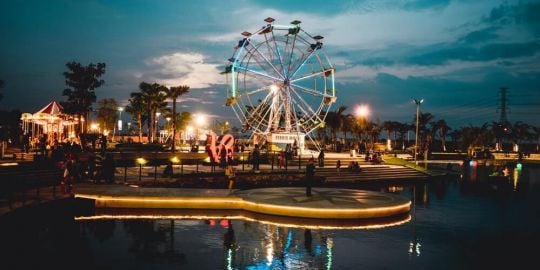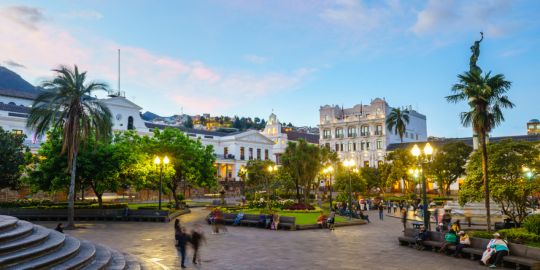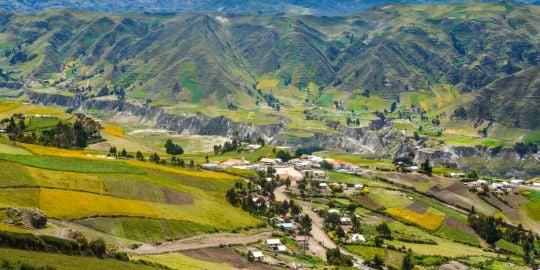Go-Bags.
As mentioned earlier on this thread, disaster-preparations officials advise citizens and residents who might be affected to have a go-bag prepared, to be used in any evacuations and/or traveling outdoors in a volcano-produced emergency.
This is a backpack containing a radio with good batteries ... non-perishable foods such as nuts and dried fruits ... water ... a flashlight ... a "95" rated dust mask ... any medicines you need to take ... a scarf and a triangular cloth to protect mouth and nose against ash.
If you can recall old Wild West movies and TV shows, you have an idea about this cloth from what the bandidos were wearing across their lower face during the stagecoach robbery.
The cloth should be moistened before wearing.
A cell phone might be a good addition, too.
cccmedia in Quito
How Safe Is Quito From Cotopaxi?
Evacuation planning.
The government has been erecting green signs on the roadways for evacuation (Evacuación) and safe sites (Sitios Seguros).
In an emergency, plans call for patrol vehicles to warn the citizenry. Radio and television programing will broadcast information.
The government has arranged for extra food and medicine to be brought to affected areas.
There are designated safe sites where food, water, medicine and other supplies will be available to those in need in an emergency.
cccmedia in Quito
Getting to Higher Ground.
Historically -- for instance the last Cotopaxi major eruptions in 1877 to 1880 -- any mudflows with debris have followed the low-lying rivers and river-bed areas.
Therefore, this strategy of seeking higher ground, is advisable.
A questioner asked specifically about whether major roads would be clear, and was told that there are too many variables in play to predict whether route 35 or other roads would be problematic for vehicles headed to the sierra or high ground.
cccmedia in Quito
Areas that might be affected.
A map shown at the Town Meeting showed that in the 1877 aftermath of a Cotopaxi major eruption, mudflows with heavy debris essentially moved southwest of the volcano ... away from Quito and reaching as far away as Guayaquil and the Pacific Ocean.
The city of Latacunga was in the path of these previous-era mudflows. So were Los Chillos, now part of the Quito suburban area.
cccmedia in Quito
The Embassy in an Emergency.
The meeting was told that the U.S. Embassy in Quito is required to remain open in a volcano emergency.
The embassy's emergency phone number is 02 - 398 5000.
Another number, a cellphone, is listed at 09 - 9788 3222.
cccmedia in Quito
Other tips, facts and recommendations from the Cotopaxi Town Meeting in Quito.
-- Families should know their kids' school evacuation plans and co-ordinate the family's evacuation plan with what the school is doing.
-- Volunteer leaders are being trained to assist citizens in an emergency and direct them or aid them in getting toward safe sites.
-- Advance evacuation may be advisable to some families living near Cotopaxi, even before a potential mudflow has begun. The likelihood that a mudflow will start may be known ahead of time due to volcano monitoring equipment and can be broadcast then.
-- The meeting was shown slides of the Pichincha volcano event of 1999, when ash covered cars and surface areas in much of Quito. Pichincha is much closer to the capital's populated areas than is Cotopaxi (the latter being 35 miles or 50 km from Quito).
-- Ambassador Namm explained that the worst-case scenario of debris-filled mudflows is possible because there are "billions of cubic feet" of ice in the Cotopaxi ice caps, which could be melted by a major eruption, producing fast-flowing mud rivers down the mountain and beyond.
cccmedia in Quito
Volcanic history of Cotopaxi.
From the town meeting...
There have been 19 major volcanic eruptions in the past 2000 years.
The most recent ones before this month were in 1877-80, 1788, 1744, 1534 and in the 9th century A.D.
A major eruption has occurred at Cotopaxi, on average, once ever 117 years.
cccmedia in Quito
Extended reach of mudflows.
In 1877 and some other major eruptions previously at Cotopaxi, so much ice-to-water conversion was produced that debris-and-mud flows reached as far away as the Pacific Coast and the Amazon rain forest.
One official described a mudflow as being like "an 18-wheel truck flowing downhill with huge rocks" along the way.
Source: the town meeting at the U.S. Embassy in Quito
cccmedia in Quito
Protection from Ash.
Meeting participants received a document titled "Emergency Preparedness - Volcano Eruptions."
From that document --
"Your Health: Since ash may cause discomfort to the respiratory tract, eyes and nasal passageways, it is highly recommended to stay indoors during periods of ash fall. If you must go outdoors, it is essential to wear masks to protect airways. Local hardware stores carry facemasks, often in the paint section. Safety glasses can be used to care for the eyes. Avoid wearing contact lenses, as the ash can get underneath the lenses and scratch the eyeball.
"When outdoors, it is advisable to wear long sleeves, pants and closed-toe shoes. In the case you do not have a face mask on hand, it is possible to use a damp cloth to make a mask. People who suffer from chronic respiratory diseases and children with allergies should take extra precaution to avoid the outdoors."
cccmedia in Quito
From the Al Jazeera LA news page Saturday 22 Aug
Another plume of ash and steam rose 1 km above rim of volcano. Of the towns evacuated some remained to herd sheep and cattle to safety
An oddity of the weekend Town Meeting at the U.S. Embassy was how many questions were being asked in Spanish.
One after the next, Latina women stood up. Each respectfully asked her question in Spanish ... it was then translated aloud into English by the Embassy's highly competent translator ... then answered in Spanish by the panel ... then translated to English again by the Embassy man.
Who were these Latinas who evidently had met the meeting-participation requirement to bring a United States passport?
Possibly the passport-carrying wives of native U.S. citizens who have moved to Ecuador.
cccmedia in Quito
The nature of Cotopaxi ash and water-supply effect.
Freshly-fallen ash particles can have acid coatings which may cause irritation to the lungs and eyes. This acid coating is rapidly removed by rain, which may then pollute local water supplies. Acidic ash can also damage vegetation, leading to crop failure.
In most eruptions, volcanic ash causes relatively few health problems while generating much anxiety. People can be more fearful of the health hazards of volcanic ash and gases than of the risk for dying from more major hazards such as debris-filled mud flows. However, ashfalls can affect wide areas around volcanoes and cause major disruptions to normal living.
Medical services can expect an increase in cases of respiratory and eye symptoms during and after an ashfall event.
source... "The Health Hazards of Volcanic Ash," a document handed out to participants in the Embassy Town Meeting.
cccmedia in Quito
Effects of volcanic ash on the body.
Pain and itchiness in the eyes can result from ash contact.
Corneal scratches and eye inflammation are possible.
Contact-lens wearers should remove the contacts to prevent tiny ash particles from getting inside them and causing irritation and scratching.
Common respiratory effects include nasal and throat irritation and breathing discomfort. People with pre-existing chest pain problems may experience such symptoms as hacking cough, wheezing and shortness of breath.
Less common but possible are outer skin irritations.
source: "The Health Hazards of Volcanic Ash" handout.
cccmedia in Quito
The impact of ashfall on roads, power, water supplies and other systems.
Ashfall may reduce visibility for drivers, possibly causing accidents. The situation is compounded by ash covering roads -- producing slippery conditions. Thicker deposits of ash may make some roads impassable.
Power outages may result from ashfall, cutting off access to cooking and other infrastructure that requires electricity.
Even small amounts of ash may compromise potability of drinking water. There can be water shortages and clogging of water supply equipment.
Municipal sanitation systems may temporarily be disabled, resulting in disease.
Roofs can collapse under the weight of ash. Cleaning of roofs has produced injury and death to persons standing on the roof in the act of cleaning.
source: "The Health Hazards of Volcanic Ash"
cccmedia in Quito
How to protect yourself against ash.
Stay inside, and limit driving.
Wear dust masks. If not available, use moistened scarves or cloth covering nose and mouth. Protective glasses or goggles should be used to protect the eyes.
Keep all doors and windows closed whenever possible.
Have stores of safe drinking water on hand, enough for at least one week.
Ash-covered vegetables grown in fields should be washed with clean water before eating.
Clean-up... Lightly water down the ash deposits before they are removed, by shoveling, being careful not to excessively wet the deposits on roofs -- which could cause excess loading and danger of collapse. Dry brushing can produce high exposure levels and should be avoided.
Hosing uses large amounts of water and could cause water shortages in highly populated areas.
Children... Kids should be kept from high-energy playing to avoid heavy breathing that could result in excess inhalation of ash particles.
source: "The Health Hazards of Volcanic Ash"
cccmedia in Quito
Embassy STEP program.
The U.S. State Department is urging all U.S. citizens living in or traveling to Ecuador to register their presence in STEP, the Smart Traveler Enrollment Program, so the Embassy has their information in the event of an emergency or disaster.
The State Department's message says "it is imperative that you keep your passport vald for travel...
"The key to surviving a natural disaster is planning."
Relevant websites... www.travel.state.govhttps://step.state.gov/step/
cccmedia in Quito
Emergency Communication Sites for Cotopaxi -- Part 1
To assist U.S. citizens in the event of major Cotopaxi volcanic activity, the U.S. State Department has issued a list of emergency-information websites and related information....
Ecuador's Ministerio Coordinador Seguridad
www.seguridad.gob.ec
Secretariat of Emergency Management
www.gestionderiesgos.gob.ec
U.S.Embassy Contacts
Phone 398-5000
Twitter: https://twitter.com/usembassy_quito
Facebook: www.facebook.com/USEmbassyQuito
General, Police and Fire: 911
Official TV in Ecuador
TV Canal 7, nationwide
Official Radio in Ecuador
Radio Publica del Ecuador 105.3 FM ...
The frequency may vary by province.
Emergency Communication Sites for Cotopaxi -- Part 2
Instituto Geofisico: The organization doing the volcano monitoring services. It posts bulletins throughout the day, including volcanic activity, tremors and earthquakes.
Website www.igepn.edu.ec
Twitter https://twitter.com/IGecuador
Ecu 911: Integrated Emergency Services will provide information about emergencies, road closures, accidents and resources available for the general pubic. It coordinates actions for the National Police, the Armed Forces, Fire Departments and the Red Cross, among others.
www.ecu911.gob.ec
Cruz Roja Ecuatoriana: Red Cross recommendations and general safety information...
Website www.cruzroja.org.ec
Twitter https://twitter.com/cruzrojaecuador
National Weather Service reports on weather systems and winds. This information assists in determining where ash will fall.
Twitter https://twitter.com/inamhi
Quito-Specific and Quito International Airport Information
Municipality of Quito: Evacuation or emergency actions specific to Quito
Website www.quito.gob.ec
Twitter https://twitter.com/MunicipioQuito
Quito Airport
Phone +593 (2) 395-4200 x2001-2008
Website www.aeropuertoquito.aero
Webste for Flight Status
www.aeropuertoquito.aero/en/flights-and … ivals.html
.
Thank you ccmedia for getting this information out to everyone.
Great job!
Patrick
Reports from the EC Coast -- both from a member of this Ecuador forum and from a blog moderator in the Salinas area -- say there will be an emergency-preparedness meeting this Saturday, September 5th (2015), in the town of Olón. Sessions in both English and Spanish would be available.
Cotopaxi ash-effects and the El Niño situation may both be discussed.
Our member has posted the meeting details at a thread accessible through this link...
https://www.expat.com/forum/viewtopic.p … 01#2824185
Cotopaxi volcano remains active.
The Volcano Discovery website updated the situation on Friday (September 4, 2015) as follows...
On September 2nd, an "eruption column" reached a height of four kilometers or 2-1/2 miles and ash drifted westward.
"Fine ash fall" reached Santo Domingo de los Colorados (Ecuador's fourth largest city, located between Quito and the Pacific Coast) and Manabí (coastal province and city).
source: www.volcanodiscovery.com
cccmedia in Quito
As has been clearly pointed out by cccmedia,
The primary affect on Quito proper would be an ash cloud and resultant ash fall on the city.
Depending on the size of the ash cloud and prevailing winds, a cloud covering all or a part of Quito could impact various parts of the cities infrastructure. There are a number of variables which would affect this situation. Speaking of winds, El Nino is started by a decrease of, or cease in the flow of the trade winds, along the equator. This allows the water temperatures to rise all along the equator. Which if followed runs right smack into Ecuador.
So under the right circumstances an ash cloud could cover Quito, and remain stagnant for a number of days. Again, several factors can affect or prevent this.
Volcanic ash is comprised of various elements; ash, silica, acids, rock etc. These particles are very abrasive. Dry ash is non conductive (Will not conduct electricity), but once wet the ash accumulation on electrical lines can produce flash-overs, where electricity takes the least path of resistance and can jump insulators or jump to another source of ground in other equipment or structures. This can result in a loss of the electrical grid.
The wet heavier ash also increases loads and can cause collapse of structures. The wet ash will be very difficult to drive in and will hamper or even prevent the mobility of emergency providers. Another factor is the introduction of ash to potable (drinking) water, and sewage systems. Contamination and blockages will result and can cause a source of flooding due to backups in the system.
As pointed out the ash can also cause various health issues; respiratory, visual, abrasions as well as acid reactions. the ash being in a fine state similar to "Talcum" powder means it will get into everything. Any system or equipment that uses normal ventilation will become clogged, and cease to function; emergency generators, cars, planes, ventilation and air conditioning systems. Equipment will also be affected if buried in ash, as they will overheat.
A few inches of ash, can have a major effect on things. Consider the effects of two feet or more.
Sitting home numb with the fear of "What If", or taking no action at all, will have the same result. There are many simple measures, which will not break the bank that anyone can take in preparation for many events. There is no need to go overboard and buy; generators, water purification systems, stockpile excessive amounts food and water, etc. You can go to extremes if you like, but it is really not necessary.
If you take any of the preparation lists from this site or any other source, and focus on the basics needed you can put together a kit for your family. Focus on what you need vs. what you may want for creature comfort. if you are forced to travel, you can only carry so much.
In the end, even if nothing happens. You will always have the resources needed ready, just in case. Any perishable items can be rotated into your daily use and be replaced with fresh items. Even something as simple as teaching yourself and your family "Basic First Aid", will be valuable for life.
message deleted
NE1,
Thanks for the support. 
message deleted
The Ecuadorian press remains muzzled -- it can legally report only what the government tells it about Cotopaxi -- but an Australian news outlet got out a story on the volcano's effects on the city of Latacunga and towns nearby.
This, from news.com.au :
Over 27,000 students have been relocated to schools outside the danger zone.
The government has been running an education and training program teaching the public how to respond in case of a major eruption -- including mock evacuations.
In Latacunga, café owner Mauricio Andrade of El Gringo y La Gorda -- The Gringo and the Fat Lady -- said customer traffic is off sharply.
"One fifth of the community has left, some forever," said Andrade.
He said that the closing of the Cotopaxi national park has ruined the tourism business in Latacunga.
news.com.au
.
cccmedia wrote:The Ecuadorian press remains muzzled -- can legally report only what the government tells it about Cotopaxi -- but an Australian news outlet got out a story on the volcano's effects on the city of Latacunga and towns nearby.
This, from news.com.au :
Over 27,000 students have been relocated to schools outside the danger zone.
The government has an education and training program teaching the public how to respond in case of a major eruption -- including mock evacuations.
In Latacunga, business owner Mauricio Andrade of El Gringo y La Gorda -- the Gringo and the Fat Lady -- said customer traffic is off sharply.
"One fifth of the community has left, some forever," said Andrade.
He said that the closing of the Cotopaxi national park has ruined the tourism business in Latacunga.
news.com.au
.
Reading between the lines... if you're a bit of a gambler, now is the perfect time to buy up vacant land in the area.
jessekimmerling wrote:cccmedia wrote:The Ecuadorian press remains muzzled -- can legally report only what the government tells it about Cotopaxi -- but an Australian news outlet got out a story on the volcano's effects on the city of Latacunga and towns nearby.
This, from news.com.au :
Over 27,000 students have been relocated to schools outside the danger zone.
The government has an education and training program teaching the public how to respond in case of a major eruption -- including mock evacuations.
In Latacunga, business owner Mauricio Andrade of El Gringo y La Gorda -- the Gringo and the Fat Lady -- said customer traffic is off sharply.
"One fifth of the community has left, some forever," said Andrade.
He said that the closing of the Cotopaxi national park has ruined the tourism business in Latacunga.
news.com.au
.
Reading between the lines... if you're a bit of a gambler, now is the perfect time to buy up vacant land in the area.
There are a whole lot better deals going on right now. Brazil just got downgraded to Junk on Wed. You can buy real assets there for 40% -50% off. They will kiss your feet if you bring them dollars right now.
Patrick
Enfusia wrote:There are a whole lot better deals going on right now. Brazil just got downgraded to Junk on Wed. You can buy real assets there for 40% -50% off. They will kiss your feet if you bring them dollars right now.
Patrick
Can you take those assets out of Brazil? If not, it's not much of a deal.
mugtech wrote:Enfusia wrote:There are a whole lot better deals going on right now. Brazil just got downgraded to Junk on Wed. You can buy real assets there for 40% -50% off. They will kiss your feet if you bring them dollars right now.
Patrick
Can you take those assets out of Brazil? If not, it's not much of a deal.
Yes you can.
There was a good profit on Wed. The Real tanked, the dollar moved against it but the Peruvian Nuevo Sole didn't. Somebody was asleep at the wheel. I bought Reals, moved them to Soles and back to dollars in an hour and a half and picked up 21% net.
Whenever a currency takes a sharp drop there are nearly always short openings like that. You do need to be packin a set to do it because they could update their currency at any moment and you could be stuck with the 1st currency such as Reals.
It worked real well on that 2nd to last Ruble drop Russia had too.
Anyway, I was just saying that there are opportunities everywhere.
Hi everybody,
We are drifting off topic here.
I remind you that the title of this topic is : "How Safe Is Quito From Cotopaxi?" 
Thanks,
Priscilla 
message deleted
It is wonderful. Quito can be affected by that?
END OF STATE EMERGENCY
QUITO, Ecuador (AP) - The state of emergency and the news blackout imposed by the government for the revival of the snowcapped volcano Cotopaxi ended Tuesday after 60 days of validity.
On August 15 the president, Rafael Correa declared a state of emergency in order to provide financial and material public and private sector resources to address the emergency.
Additionally ordered a blackout on information related to the activity of the volcano to avoid alarm among the population.
The official newspaper The Citizen said the Security Coordinator, Cesar Navas, minister announced that "the state of emergency will not be extended."
The Cotopaxi volcano, 50 kilometers south of the capital, is a snow cone of 5,897 meters high, it is located in the central Andes of Ecuador. Nearby are towns like Latacunga, Salcedo and others. Its last eruption was in 1877.
A possible eruption of this colossus, could affect about 110,000 people in the province of Cotopaxi, where the snow is; 80,000 to 120,000 in the neighboring province of Pichincha, with capital Quito, and another 15,000 in the neighboring province of Napo also, according to the magnitude of the eruption.
Or this is just another part of the "Blackout"?
Thank you for the update.
Patrick

message deleted
I saw new date a few days ago and, yes, it would appear that pressure is mounting.
With the pressure it's holding now, if it let it all go at once, they estimate bigger than its last big one.
Will it let it all go at once? That's the $64,000 question.
Patrick
Nataly Elena 1 wrote:Redouble your preparedness. Cotopaxi is more dangerous than ever. Do not let down your guard! Cotopaxi is a ticking time bomb....Cuenca Highlife update.
Due to the nature of this post, some members may wish to see the article on which it was based.
The article is titled "Don't forget Cotopaxi, officials and geologist warn; they say the danger of an eruption continues to grow despite the public's 'volcano fatigue' " ....
Link: www.cuencahighlife.com
As of the moment -- the morning of Sunday, November 8, 2015 -- the article is second up on the site's welcome page. If it has been moved, use the Custom Google Search on the site for the word Cotopaxi.
cccmedia in Quito









